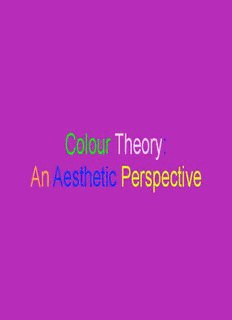
Colour Theory: An Aesthetic Perspective - Emily Carr University of PDF
Preview Colour Theory: An Aesthetic Perspective - Emily Carr University of
Colour Theory: An Aesthetic Perspective • Though not amenable to definition, art can be analyzed under various headings — representation, coherent form, emotive expression and social purpose. •Aesthetics is the philosophy of art. 2 egyptians had 17 pigments/colours Egypt All pigments are mineral painted by “outline scribes” paints are mixed with gums degraded after tombs are opened light is made out of particles that emanate out Plato: “like fire” colour is small: white as mixture emission causing “Double dilation & vision” increasing visibility large: black as intake contraction A thing is not seen because it is visible, but conversly, visible because it is seen. we don’t see any of the colours as PURE, only the mixtures 6 Aristotle: FIRE is precondition (dynamis) of vision Light is ENERGEIA of fire Colour (opacity) is transition from dynamis to energeia = colour reflects not apperance, but condition of things diference of objects depends on shadow light & angle colour eye fire -object 7 painted sculptures interior walls • Pliny ”Natural History” • there are only 4 colours * • White from Milos • Red from Sinope and Black Sea • Yellow Attic • Black “Atramentum” • *make 819 tonal variations • used by Appeles- the most celebrated Greek painter 9 • Blue is made out of black + white • 4 basic Pigments are related to 4 HUMORS (elements) • Empedocles: • Mixing colours is a TEMPLE = OFFERING • Irreversible process • Latin: TEMPERA = MIXING • (Temple- tempera- temperament- temperature) 10
Description: